TOO MANY GOOSEBERRIES
Am I a Hoarder?
I once had what may have been the largest collection of gooseberries in this country east of the Rocky Mountains — four dozen or so. Many more existed and exist in collections across “the pond,” especially in Great Britain. That was due, in large part, to the gooseberry contests held annually since the 18th century in the clubrooms of inns, especially in Lancashire, Cheshire and the Midlands. Flavor be damned: rewards went for the largest berries. The gaiety of singing and refreshments at these shows was offset by the solemn weighing of fruits.
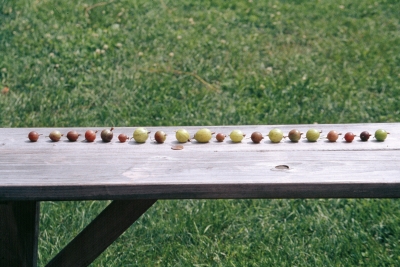 Those winning berries were the handiwork of amateur breeders and some rather esoteric horticulture. Suckling a promising berry, for example, whereby a saucer of water was perched beneath an individual berry throughout its growth, just high enough to wet only its calyx (far end).
Those winning berries were the handiwork of amateur breeders and some rather esoteric horticulture. Suckling a promising berry, for example, whereby a saucer of water was perched beneath an individual berry throughout its growth, just high enough to wet only its calyx (far end).
The U.S. Government to the Rescue
Gooseberries, while popular in northern Europe, are relatively unknown here in the States. Although gooseberries, along with blueberries, were just beginning to become popular here by the end of the 19th century, blueberry’s popularity continued its upward trajectory, while gooseberry’s was cut short. Gooseberries were implicated, along with currants, for the spread of white pine blister rust, a disease also of white pines. White pines were an important timber crop; gooseberries were commercially unimportant.
In the early 1900s, the federal government imposed a ban on growing gooseberries and currants. Many Civilian Conservation Corps crews were kept busy in the 1930s ripping wild plants out of forests and cultivated plants from backyard gardens.
The ban was generally ineffective, in part because of all the wild gooseberry and currant hosts for the disease, as well as the long distance — even hundreds of miles — potential spread of its spores. The Federal ban was lifted in 1966. Still, by then two generations of Americans had forgotten about the fruit.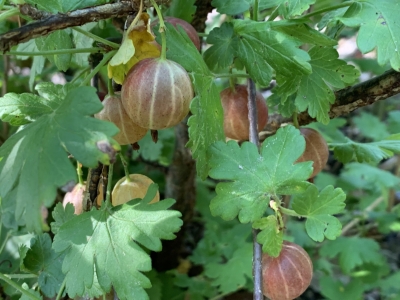
But not me! I nurtured my dozens of varieties and enjoyed the fruit. Not all the fruit, though. Spinefree, for instance, was notable for its lack of spines; the fruit itself was small, tough, and tart. But I was creating a collection, and I kept growing the plants to preserve them in case no one else had them.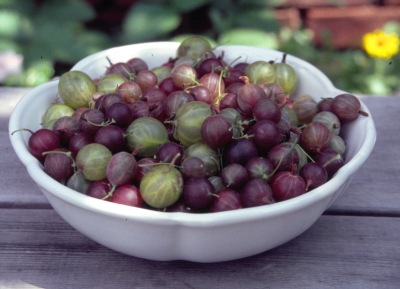
The federal government came to my rescue around 1990 with GRIN, short for the Germplasm Resources Information Network of the US Department of Agriculture. The USDA was putting together sites where many or most of various cultivated plants could be maintained. Corvallis, Oregon became the site designated for the gooseberry collection. I was more than happy to contribute plants or cuttings of gooseberries in my collection.
An Unwelcome Visitor Makes its Appearance
That was the first paring down of my collection. Disease caused the next one, specifically American powdery mildew. I had been spoiled by never having to deal with any pest problems with my gooseberries. In retrospect, it was inevitable, importing so many plants into my garden from fellow enthusiasts, nurseries, and research centers, that some pests would hitchhike in on the plants and find the climate and growing conditions here to their liking.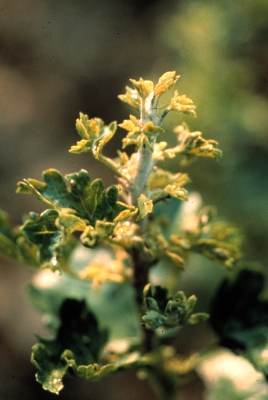
A gooseberry variety’s ancestry could be the European species, the American species, or some mix of the two, perhaps also throwing some other species into the mix. American varieties of gooseberry, having evolved with the mildew, can generally fend off American powdery mildew. Not so for most of the European varieties, which is most unfortunate since those are among the best-tasting varieties in my collection. Bite into one of these; the sweet flavor is reminiscent, depending on the variety, of such flavors as that of plum, apricot, or grape.
Rather than bother combatting the mildew with even an organic spray, such as oil or sulfur, I culled these plants from my collection. Too bad, because one of my favorites was the appropriately-named variety Colossal. When I bit down on this berry, the taut skin exploded in my mouth with a sweet ambrosial juice. And to think that so many people think all gooseberries are small, green, and tart! Ha. (Colossal was green, though.)
So also out went Whitesmith, Whinham’s Industry, Early Sulfur, and Invicta.
What Goes? What Stays?
I’m contemplating the third paring down of my gooseberry collection. The main reason is that my current dozen or so varieties offer me more fruit than I could possibly ever eat. And there are those — Red Jack and Glendale — that taste pretty much the same as each other. And those — Early Sulfur and Oregon Champion — that hardly bear any fruit. And those — Canada 0273, Welcome, and Resistenza — that really don’t have top notch flavor. (I’m shedding my emotional attachment to the Welcome gooseberry plant, even though it was my first gooseberry, having been with me for decades and traveling with me as I relocated from Wisconsin to Delaware to Maryland and then to here, New York.)
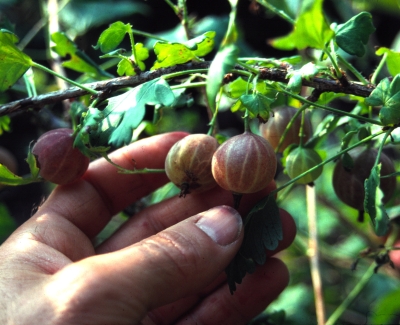
Canada 0-273 gooseberry
I suppose making gooseberry jam or the classic British dessert Gooseberry Fool would make good use of all the excess fruits and preserve them for later use. But I’ve tried making both those delicacies. The muddy purple jam turned out to taste as bad as it looked, and I thankfully can’t remember what the Fool tasted like. But it was not good.
So I’m keeping the best of the best that I have here in terms of performance and flavor. And they are . . . (drum roll) . . . Poorman, Chief, Red Jacket, Black Satin, Captivator, and Hinonmakis Yellow. M-mmmmmm.

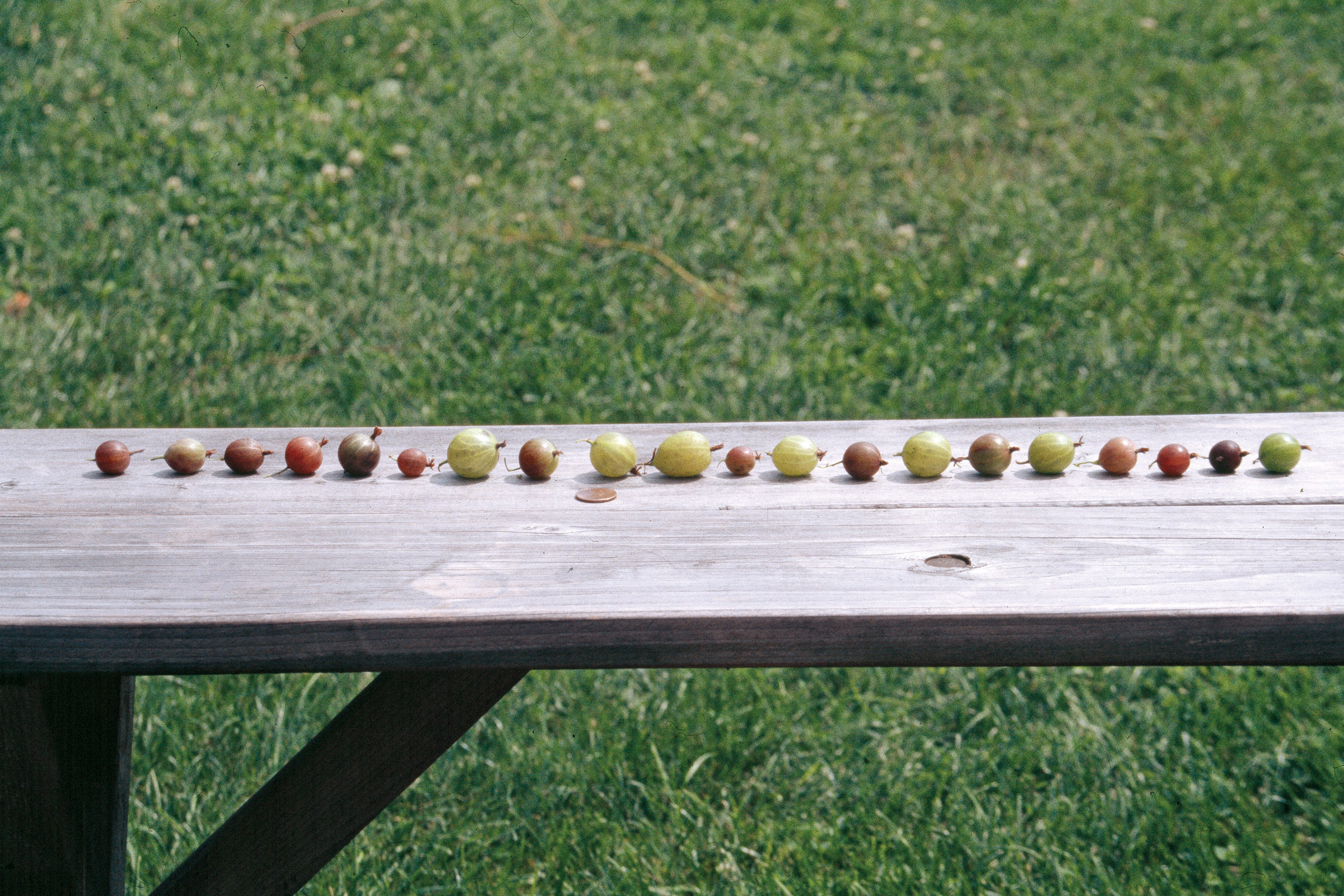

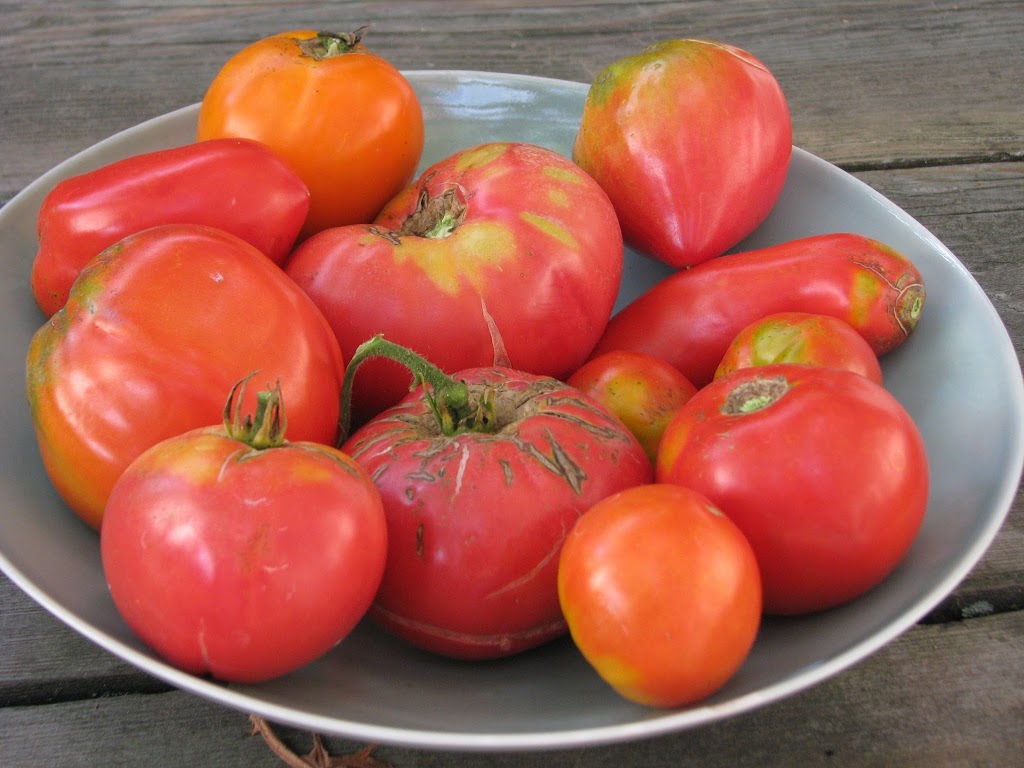
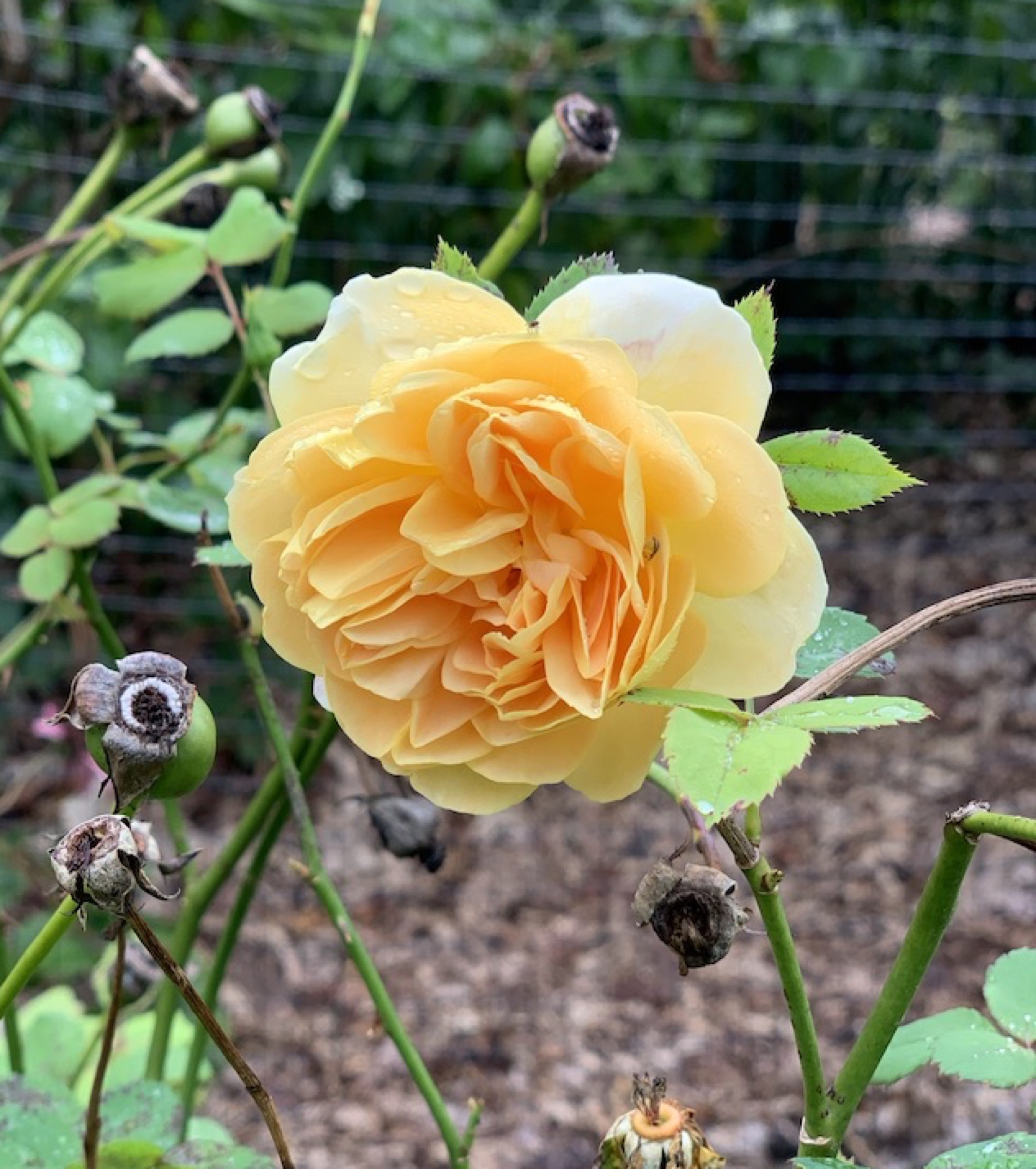
Nice read! What do you think of the Hinnonmaki Red then?
I know most people say that Hinnonmaki Red is really good. I disagree. But Hinnonmaki Yello is one of my favorites, but a little weak growing.
What do you think of the gooseberry named “Jacob”?
I’m not familiar with that variety.
Nice! I discovered Ribes when I moved to Germany, and red currants are my favorite fruit now. I’m not so fond of black currants, but standing in the middle of a bush harvesting smells like heaven.
I don’t have any gooseberries, as I am anti-thorns, but lots of named and un-named white, red, and black currants, one American clove currant, and one Jostaberry, which is an interesting (thornless!) cross of European and American currants and gooseberry. It’s sour and tasty unripe and green, and sweet and a bit bland ripe and black.
Black currants are one of my favorite fruits! Perhaps you need a better tasting variety. Belaruskaja is one of my favorites. For a delicious, thornless gooseberry, I recommend Captivator. Jostaberry generally means any one of a number of hybrids of gooseberry and black currants, so they’ll vary in flavor and growth. Although I love both parents, I was never crazy over any jostas I tried. I have a new one that perhaps will change my mind about them.
The ones with thorns are smart plants, they know how to protect them. There is a trick to harvesting it. You ease your hand all the way in, grab the whole branch loosely and pull outwards.
Because the Thorns are facing outwards, they dont poke you andddd you can use leaves to cover them along when pulling gooseberries. you can even pull hard enough to break the leaves and its okay because it wont hurt u and you will give other branches more light ! win win
Lee, I am curious, do you net your gooseberries to protect them from birds & squirrels?
Oddly, nothing seems to get my gooseberries, except my ducks if they could get past the very low fence around that part of the garden. They stay pest free probably because I have 2 outdoor dogs and 1 outdoor cat. For you, 1/2″ hardware “cloth” cylinder topped with a net might work.
Hi Lee – how do you cover the berries? I have used netting over them and stakes to secure it to the ground. Last year all 5 bushes were cleared out completely before anything ripened. Chipmonks/birds/deer. I was so disappointed. Please advise. Thank you.
Oddly, nothing seems to get my gooseberries, except my ducks if they could get past the very low fence around that part of the garden. They stay pest free probably because I have 2 outdoor dogs and 1 outdoor cat. For you, 1/2″ hardware “cloth” cylinder topped with a net might work.
I pulled out two gooseberry plants a couple of years ago because of their wicked thorns and poor flavor. Blueberries are so much friendlier! I’d be interested in starting over with those you recommend. Any info on growers I could get a few? I’m in
central CT. Thanks Lee for all your writings.They are a wonderful service
I like gooseberries but, in all honesty, they don’t compare with blueberries, which are beautiful plants, super productive (if gorwn right, and thornless. In my once a year sale I usually have some gooseberry plants. It’s usually end of Mayor early June.
Sadly, we had to give up on gooseberries because the chipmunks were unstoppable – they would strip the plant the second the fruit ripened. We ended up building such an elaborate cage that then it was a procedure to get in to pick ourselves, and so we wouldn’t get to it. On the other hand, our red currants do great and the chipmunks don’t outcompete us.
Cat and dogs do the trick for me.Interestingly, nothing touches my red currants either. Even hardly me.)
Nice blog Lee and I understand that collector feeling as I’ve tried many myself over the years too. What I’ve learned about most fruit plants is despite buying a cultivar not all cultivars of the same plant are the same. This also applies to blueberry as well as Rubus type fruits. A Hinnonmaki Yellow from such and such place is definitely not the same as one purchased elsewhere. Strains or sub cultivar variations exist and substandard clones get into the mix.
Hinnonmaki Yellow for me, consistently produces large fruits of over 6grams in size on a very vigorous mildew resistant plant as does my Hinnonmaki Red. Both fruited the year after planting and produce flowers in any soil pH range.
However my experiences with the much vaunted thornless Captivator have been mixed. Tried growing it twice(well established roots on 3 foot high plants) from different sources. Both times poor plant vigor, tiny sparse fruits and terrible sawfly attacks. In the end dug it up-consigned to the recycling bin. I may have been unlucky with the sources of these plants as other purchases e.g Xenia another so called thornless one ended up a vicious thorny mess prone to mildew unlike it’s descriptions from the top nursery from where I had bought.. Ripped out too!
Another thornless one I tried was Lady Sun from Swiss nursery Lubera. Delicious fruits when you can get it to flower that is. Flowers are prone to drop off in rainfall or small fruits aborted- Ribes run off? The plant is terribly thorny with new growth unlike it’s description and prone to sawfly attacks. Unlike the Hinnonmaki group it does not produce fruit on 1 and on 2 year old canes very sparsely, but produces mostly on 3year old shoots. Not worth growing as the yield is well under a Kilo on established plants. Hinnonmaki Yellow is No1 for me still!
I think a lot of what you describe might be mislabelling by nurseries. With that said, my present Hinonmaki Yellow plants seem to produce much more poorly and grow weakly as compared with my remembrance of plants I grew many years ago. “Run off”, I think, was an old-fashioned explanation for when plants underwent weaker growth or other changes due to viruses, before viruses were known. You seem to have a very nice collection of gooseberries. Too bad it’s too hard to exchange plants overseas.
The best jam I ever had was one my mom used to make with red currants and wine berries (both wild).
That sounds delicious!
Yes indeed mislabelling etc, is rife amongst even top nurseries, or especially from bargain shops. I bought a cheap Hinnonmaki Green cutting from a bargain bucket store last year and it produced the tastiest fruits I’d ever eaten. It turned out to be a Whinnam’s Industry plant, as I verified it with the shop which confirmed that the wrong lot of boxes were mixed up in packing. Said plant grew incredibly well in my awful gravel type soil and fruited mid July. The taste was vastly superior to my Hinnonmaki Red or Yellow. Nearly called it ‘Dave’s Mistake’ not ‘Dan’s’! If you know your cultivars you’ll know the reference?
In reference to vigor-fish and bone meal or treated chicken pellets work wonders!
I once grew Whinham’s Industry, and it was delicious. Unfortunately, as I wrote, that variety, along with Whitesmith and some other delectable British varieties. were too susceptible to mildew, so I dug them out.
Most of the old English cultivars are very mildew prone as you say. Once mildew resistant plants like Whinnam’s now succumb easily , because mildew has mutated many times. One old fantastic cooking/jam variety is the Woodpecker (huge 60gram goosegog fruits!) which used to suffer mildew horrendously every season in my allotment, and died out due to root ironically. The Whinnam’s just got a little bit on the odd leaf last year as did the Hinnonmaki Yellow, but nothing too major.
The Hinnonmaki Red seems pretty immune to it. I acquired a commercial selection of it 20 years ago and the same plant is still going strong. It suckers occasionally as well as rooting easily by hardwood. Fruit has a slight raspberry taste which is not my fave, so I prefer it in pies rather than for fresh eating. Jostaberry which I grew once too, never flowered in six years despite ultra vigorous growth. I gave up on that-waste of space. I will acquire some good virus free Captivator stock and give it another go soon, as it’s said it makes fantastic jam and I’ve lost count of injuries from thorns during picking time. I even got some sort of joint inflammation from it in the fingers which was a major pain for a while. However best jam I’d tried is from the Loganberry-hand’s down. Boysenberry I must try as well! My Titania blackcurrant makes tremendous jam also. Thornfree plants are the way to go!
I’m not sure, but Hinnonmaki Red may have once been called Lepaa Red. At any rate, I grew Lepaa Red, decades ago and got rid of it because of bad taste. I only grow dessert varieties of gooseberry.
Jostaberry is a catch-all term for a group of gooseberry-blackcurrant hybrids. They also have some Worcester berry in them. Some varieties are more fertile than others. I grew josta years ago but got rid of it due to mediocre favor or poor productivity. I’m trying it again not. It should fruit this summer.
Hi Lee,
I am getting a Poorman and Hinnonmaki Red based on the information I read from your website. Thank you !
I am thinking to plant them right between my blueberry patch and the herb patch(mainly thyme and oregano). Do you know if there is any incompatible crop for Gooseberry ?
Thanks & Go Badger,
Sheila Culver
No incompatibility except that blueberries need a soil a lot more acidic (pH 4-5.5) than gooseberries.
I went Badger.(Many years ago)
You folks might want to try out a really good blueberry cultivar called Emblue. Hardy and highly self fertile with good size fruits in early/mid July and ideal for containers like Goldtraube 23. There’s very little info on its actual pedigree or origins, but it’s becoming a popular cultivar in Europe. Yield is moderate/high and it has a distinct wild blueberry taste from attractive large sky blue fruits. Its grey/green lance like bushy leaves are similar to Vaccinium Augustifolium types. Moderate Chill need around 650-800 hours from my tests of the last 3 years. Moderate vigor with good suckering from the base. Around 1 metre in a large container. Disease and virus resistance are excellent and not pH fussy. Aphids leave its waxy tough leaves well alone.
It doesn’t seem like that variety is available anywhere in North America. Oh well.
Sorry about that, over here in U.K we get great U.S/Canadian developed plants like Chippewa blueberry in specialized nurseries-usually limited stock and then after becoming popular e.g Northland, Bonus, you see them more and more cropping up. Patriot and Bluecrop are sold everywhere now just like Hinno gooseberries. Captivator is getting as popular as Hinnonmaki Red, but in bigger nurseries only.
I’m not totally sure, but there is a Swiss based nursery called Lubera which might be entering the U.S domain with its plants or indeed ship your way. A really innovative company with a multitude of naturally bred plants and run by a nice fellow called Markus. I grow some delightful plants from him, such as: a blackberry called Navaho Bigandearly which is a cross of Navaho x Loch Ness. Stunning large pink rose red flowers with virtually seedless large fruit and ideal for container growing. YouTube has a nice video of it and indeed his other ones!
I’m familiar with Navaho (the “Bigandearly” probably a marketing addition), but it’s not cold hardy here in Zone 5.
Interesting about Chippewa, Patriot, and Northland blueberries. They’re both considered “half-high” hybrids of lowbush and highbush blueberries. I tasted and grew the latter two varieties, and never thought very highly of their flavor.
Lubera only sell to a few German-speaking countries in Europe.
Agree there about Patriot and Northland. I only grow because root rot resistance is high. Best tasting is Bonus-hint of peach, but plant is not hardy and dies out in Winter wet.
Navaho BigandEarly which is a distinct newer hybrid cross of Navaho original is extremely hardy to at least -30 Celsius. I grew it overseas in these cold conditions(sometimes dipping to -35Celsius) so I can attest to its hardiness. It was not affected, so Zone 5 should be no problem! Upon return to U.K, I reaquired this plant along with another excellent hybrid of Navaho called Summerlong.
It’s strange how some varieties that should do well here — like that Novaho Bigandearly — just aren’t available here in the US. Even the USDA lacks this one in their germplasm repository.
Frustrating to say the least and vice versa here with newer releases which in most cases after years of patent restrictions and then plant trials etc, you actually get to see it. Regarding ‘Navaho’ it was donated many years ago and three new plants were developed in Switzerland. All arguably surpass the original in terms of hardiness and disease resistance as the usual marketing jargon goes. The Bigandearly has done very well in my trials except yield is moderate only- 3kg. More for container growing/limited space!
Thanks for the info.
You’re very welcome Lee. I’ve just finished my last helping of Gooseberry Fool which we made from frozen Hinnonmaki Yellow fruit which we collected in mid July last year. Absolute divine, eating this as a desert over the last two evenings. Food of the Gods!
I tried making gooseberry fool last year, and it was a total flop. I’m not much of a cook with fruit.
Same with me-my efforts all proved useless. That’s why I leave it to a female family member who actually knows what they’re doing!
Looks like I won’t have to fork out the dosh for another Captivator plant. I discovered two well rooted cuttings- taken with foresight from my miserable 2nd attempt of planting of it which failed miserably last year due to my neglect and not virus etc. The cuttings overwintered and rooted impressively in seaweed enriched compost and which I’d completely forgot about as they were outside under a bench. I will give them TLC in a a large pot now!
Lee: Thank you for breaking a staff for gooseberries with your website! I just discovered it to find out that I am not the only gooseberry hoarder, which is nice. I keep about 40 plants of 19 varieties in my backyard and I enjoy all of them.
Besides eating them fresh and making jam, one of my favorite uses of gooseberries is making wine. I recently learned that even my great-grand-father already made wine from gooseberries in Germany in the early 20th century. I find gooseberry wine quite delicious, especially using modern wine-making methods. All my friends like it as well, which I did not expect initially because its taste is so unique.
I hope you will not entirely give up on gooseberries…
Ralph
Definitely not giving up on gooseberries. I just want to stop growing varieties that I don’t like as well as my bestest.
Glad to hear that, but I am with Captivator as my cuttings have suddenly died. That’s me done with that cultivar. Have a huge crop developing at the other end of the ‘wild’ garden which is either a Careless or Jubilee cultivar donated from a local allotment decades ago. Huge fruits and no mildew as yet!
What about flavor?
Careless is culinary mainly, but Jubilee is said to be an improved form of it(more mildew resistant!) and can be used as desert too. However, both are excellent for Gooseberry Fool flavorwise. Not sure which cultivar I have. Sawfly is an absolute pain in U.K at moment due to a really hot June and little rain over the past 6 weeks.
Interesting that I used to get sawfly every year, but not anymore. Why? Who knows?
I tried making Gooseberry Fool last year. It was awful. I can’t understand why; it’s so simple and ingredients are so tasty. Any direction would be appreciated and might make me give it another try.
I noticed where I planted the aromatic shrub Sandlewood I never see the critters at all on gooseberry plants, but Sandalwood is quite prone to mildew and can spread it. Hard to propagate too!
I don’t actually make Gooseberry Fool anymore as my previous efforts were a disaster, so I can relate to what you say. Perhaps someone here could kindly chime in and give us the ‘secret’ or at least tips?
A number of different fungi cause mildew, and any one of them only infect specific plants. So the sandalwood mildew might not affect gooseberries at all. A quick web search turned up Podosphaera mors-uvae (formerly Sphaerotheca mors-uvae) as the powdery mildew of gooseberries, Pseudoidium santalacearum as the powdery mildew of sandalwood.
That is interesting info and very useful to know. Many thanks.
p.s the cultivar in my wild garden is confirmed as ‘Careless’; huge fruits and surprisingly not one iota of mildew on the plant, as it is said to be prone by many sources.
I probably wrote this earlier, but I gave up on pretty much all the British gooseberry varieties. Too bad, because I know that Whitesmith and Whinham, for example, are very delicious.
As I’m moving now-downizing mainly because the garden is too big and a quite a veritable monster to maintain(Leylandii least of my worries etc!!!) I shall only be taking fruit plants which actually have both flavor and some verified disease resistance. Moreover your article inspired me and made very good sense, so thankyou Lee.
Hinnonmaki Red though being a long stalwart in the garden for two decades along with a few others- blackberries, blackcurrants etc included , will be reluctantly left. Needs must! My treasured Hinnonmaki Yellow will be taken as it has a delightful taste and crops really well, plus it was a commercial strain and extremely hard to come by. ‘Gardening’ is full of tough choices and more to make no doubt. Ah well!
I know what you mean. I’m trying to reduce my plants to the best of the best. No more of trying everything.
Hi, I have an Invicta gooseberry, the berries turn red, most of the nursery centers claim it is a true green berry type, but a few also say they turn red. I know you said you used to grow it before, was it truly green and stayed green or did they turn red on you? Thanks.
In all honesty, I can’t remember. Fruit color, within reason, can be influenced by temperatures and the amount of sunlight.
OH interesting!!, I will try mine again this season and see what it does. Most of the nursery centers seem to advertise it as pure green, when you ask them, none of them know as they mostly seem to be middle sellers, not the growers of them. I tried to find info on the original Invicta, origins, etc but am not seeing anything yet. Thanks for the info!
I live in Sweden and here Invicta is yellow.
Thank you, I am thinking the Invicta I have was wrong. I purchased another one from someone who said theirs ripens to yellow. Thanks for the info 🙂
I think your red Invicta is a mis-labeled cultivar. Authentic Invicta is green, ripening to white with many short bristles. An excellent source for authentic gooseberry images is RV Rogers website: https://rvroger.co.uk/gooseberry-invicta/
I found an interesting open access (free!) scientific article concerning DNA analysis of 242 gooseberry cultivars. This demonstrated the heritage of some of the cultivars but also showed that there are mis-named cultivars all over the place. In particular I noticed that the “Whinham’s Industry” they obtained from Chris Bowers Nursery in the UK was NOT true to type and was instead Hinnonmaki Red!! Also their Langley Gage and Leveller were the SAME but were not either cultivar! Instead they both were Hinnonmaki Yellow!!
If interested, here’s the link to the free article. Check out the supplementary material section.
https://www.sciencedirect.com/science/article/pii/S0304423822005581
Bill Dailey
Great information! Thanks. I’ll check all this out. The internet at its finest.
Wow, great you had collected so many varieties! I’m wondering what we have on our property-maybe you might know. My mother in law says it has been growing here as long as she remembers-she is 90. The property is in Plattekill NY and was first cultivated in the late 1700’s. The berry is small, red-purple and very sweet. It is the sweetest and earliest one in my collection of 6 or 7 varieties. I have propagated it so I have several bushes. It has dark bark when it gets older, I feel like that is different from the others. I bought lots of varieties because I love gooseberries but this one which I call Grandma’s Gooseberry is my favorite. Any idea what it might be?
Send me a photo of berries and bark and I may be able to help you. Or bring some over. But keep in mind that there are many varieties of gooseberry. My initial collection of 50 only scrathed the surface.
Is there no place you can identify it through DNA Barcoding? Maybe some University?
There probably is but I not pursued it.
Hi Lee,
I also have a large collection (25 or so) of gooseberries right outside of Philadelphia. Ed Mashburn (former president of TIRA) was a good friend and collaborator. I’ve been searching for authentic Whinham’s Industry for over 25 years. So far all of the plants are “faux” Whinhams Industry, being either Poorman or more commonly Hinnonmaki Red. Do you have a source of authentic Whinham’s? Lucile Whitman supposedly had it but her plant turned out to be Poorman. Corvallis supposedly had it but it wasn’t the authentic cultivar.
Thanks
Bill
I remember Ed, even visited once probably back in the ’90s. I was on the board of TIRA. It was lots of fun.
I did have what I believe was the real Whinham’s Industry. Can’t remember where I got it, but eventually got rid of it, along with Whitesmith, Jumbo, and some other delectable gooseberries that were too prone to disease.
Steve McKay is who put TIRA together while he was teaching in California. He subsequently moved to my neck of the woods, here in NY’s Hudson Valley, and worked for Cornell. I have been out of contact with him for years but I see that he offered the Ribes part of a Cornell Program in 2021 (https://rvpadmin.cce.cornell.edu/pdf/event_new/pdf62.pdf). I have his contact from about 10 years ago. I’ll send that information to you email.